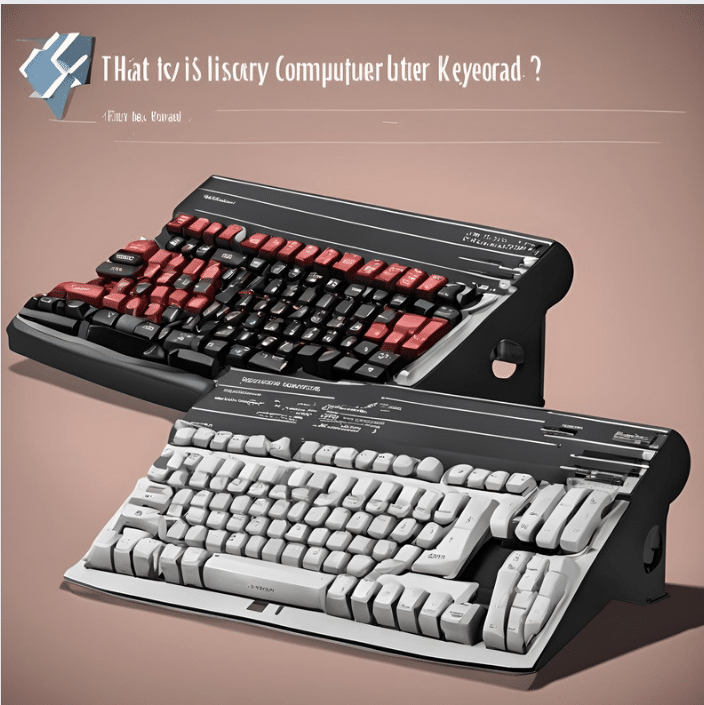Unraveling the History of the Computer Keyboard
Introduction
- Hook: Start with a vivid scene of a person typing on a modern keyboard.
- Thesis Statement: Introduce the article’s purpose of tracing the evolutionary journey of the computer keyboard, highlighting its significance in the realm of computing.
- Overview: Provide a brief glimpse into the various historical milestones and innovations that shaped the modern computer keyboard.

Section 1: Precursors to the Modern Keyboard
- Early Typewriters: Explore the origins of typewriters in the 19th century, detailing the invention of the first commercially successful typewriter by Christopher Latham Sholes in 1868.
- QWERTY Layout: Discuss the development of the QWERTY keyboard layout, introduced to prevent jamming of mechanical typewriters by strategically placing commonly used keys apart.
Alright, let’s take a trip back in time to the early days of typing wonders. We’re talking about the 19th century here, where the clackity-clack of typewriters was just starting to echo through the halls of history.
Early Typewriters: The Birth of a Revolution
Picture this: it’s 1868, and a chap named Christopher Latham Sholes is tinkering away in his workshop. Suddenly, he has a stroke of genius—why not create a machine that can print letters onto paper with the press of a key? And just like that, the first commercially successful typewriter was born.
QWERTY Layout: Cracking the Code for Efficiency
But Sholes didn’t stop there. He quickly realized that if he wanted his typewriter to be a hit, he needed to tackle a pesky problem—jamming. So, he and his buddies devised a stroke of brilliance—the QWERTY keyboard layout.
They strategically arranged the keys to prevent commonly used letter pairs from jamming together. And thus, the QWERTY layout was born, setting the stage for the keyboards we know and love today.
Alright, there you have it—our journey into the origins of the computer keyboard begins with the humble typewriter. But hold onto your hats, folks, because we’re just getting started on this wild ride through keyboard history!
Section 2: Emergence of Computer Keyboards
- Mainframe Computers: Trace the integration of keyboards into early mainframe computers in the mid-20th century, such as the IBM 704.
- Teletype Machines: Examine the role of teletype machines in facilitating keyboard input for early computers, bridging the gap between typewriters and digital input devices.
Fast forward a bit from the clunky typewriters, and we find ourselves in the midst of the computer revolution. It’s the mid-20th century, and those big, bulky mainframe computers are starting to become a thing.
Mainframe Computers: Where It All Started
Imagine a room filled with whirring machines the size of refrigerators—that’s the mainframe computer for you. And guess what? They needed a way to communicate with these beasts, and that’s where the keyboard comes in.
Engineers started integrating keyboards into these early mainframes, giving users a way to input commands and data directly into the machine. It was a game-changer, paving the way for the digital age as we know it.
Teletype Machines: Bridging the Gap
But wait, there’s more! Before computers had fancy screens and keyboards, they relied on something called teletype machines. These babies combined the best of both worlds—part typewriter, part telegraph machine.
Users could type out their commands on a keyboard, and the machine would translate them into electrical signals to communicate with the computer. It was like magic!
Alright, there you have it—our journey through the emergence of computer keyboards. From the clunky mainframes of the past to the sleek machines of today, the keyboard has been an essential part of computing since day one. But hold onto your hats, because we’ve still got plenty more keyboard history to explore!
Section 3: Evolution of Keyboard Technology
- Introduction of Function Keys: Discuss the introduction of function keys on keyboards, initially used for inputting commands in mainframe and minicomputer systems.
- Advent of Personal Computers: Explore how the rise of personal computers in the 1970s and 1980s popularized keyboard input as the primary method of interaction, leading to the standardization of keyboard layouts and interfaces.
Section 3: Evolution of Keyboard Technology
Alright, buckle up, because we’re about to dive into the nitty-gritty of keyboard evolution. We’ve come a long way from the clunky typewriters and mainframes of yesteryear, so let’s see how keyboards have evolved to keep up with the times.
Introduction of Function Keys: A New Era Dawns
Now, let’s talk about function keys. These little guys made their debut on keyboards in the mid-20th century, and they were a game-changer. Instead of just typing letters and numbers, users could now access a whole slew of commands with just the press of a key.
Think of them as your keyboard’s secret weapon—whether you’re saving a document, opening a new window, or even launching a program, function keys have got your back.
Advent of Personal Computers: Bringing Keyboards to the Masses
Fast forward to the 1970s and 1980s, and we see the rise of personal computers. Suddenly, keyboards weren’t just for big, bulky mainframes—they were for everyone.
With the advent of personal computers like the Apple II and the IBM PC, keyboards became a standard feature of home computing. And with that came the standardization of keyboard layouts and interfaces, making it easier for users to transition between different systems.
Alright, there you have it—the evolution of keyboard technology in a nutshell. From the humble function key to the rise of personal computing, keyboards have come a long way since their typewriter days. But hold onto your hats, because we’re not done yet—there’s still plenty more keyboard history to explore!
Section 4: Modern Keyboard Innovations
- Membrane Keyboards: Discuss the transition from mechanical to membrane keyboards, which utilize pressure-sensitive rubber membranes for key activation.
- Ergonomic Keyboards: Explore the development of ergonomic keyboards, designed to reduce strain and discomfort during prolonged typing sessions.
- Wireless and Mechanical Keyboards: Highlight recent innovations such as wireless connectivity and mechanical key switches, catering to diverse user preferences and needs.
Alright, folks, let’s fast forward to the present and take a look at some of the coolest innovations in keyboard technology. We’re talking about everything from sleek new designs to fancy features that make typing a breeze. So sit back, relax, and let’s dive in!
Membrane Keyboards: Thin, Sleek, and oh-so-Satisfying
First up, let’s talk about membrane keyboards. These bad boys have been around for a while now, but they’re still making waves in the world of keyboards. Unlike their clunky mechanical counterparts, membrane keyboards use pressure-sensitive rubber membranes beneath the keys to register keystrokes.
Not only are membrane keyboards thinner and sleeker, but they also tend to be quieter and more affordable. Plus, with advances in technology, manufacturers have been able to improve the feel and responsiveness of membrane keyboards, making them a popular choice among gamers and typists alike.
Ergonomic Keyboards: Putting Comfort First
Next on our list are ergonomic keyboards. Let’s face it—typing all day can take a toll on your wrists and hands. That’s where ergonomic keyboards come in. These specially designed keyboards are engineered to reduce strain and discomfort by promoting a more natural typing posture.
Whether it’s a split keyboard that allows you to position your hands at a more comfortable angle or a keyboard with built-in wrist rests, ergonomic keyboards are a game-changer for anyone who spends long hours in front of a computer.
Wireless and Mechanical Keyboards: Embracing Freedom and Customization
Last but not least, let’s talk about wireless and mechanical keyboards. Wireless keyboards give you the freedom to type from anywhere in the room, without being tethered to your computer by a pesky cable.
And then there are mechanical keyboards— the Cadillac of keyboards, if you will. With their satisfying tactile feedback and customizable key switches, mechanical keyboards are a favorite among hardcore gamers and typing enthusiasts.
Alright, there you have it—some of the coolest innovations in keyboard technology. From sleek membrane keyboards to ergonomic wonders and customizable mechanical beasts, there’s truly something for everyone in the world of keyboards. But hold onto your hats, because who knows what the future holds for this essential piece of tech!
Section 5: Future Trends and Innovations
- Touch and Gesture Input: Discuss emerging trends in touch and gesture-based input technologies, potentially reshaping the future of keyboard interfaces.
- Integration with Virtual Reality: Explore the potential integration of keyboards with virtual reality environments, offering immersive and intuitive input methods.
Alright, let’s fire up our crystal ball and take a peek into the future of keyboard technology. We’ve seen some pretty amazing advancements so far, but trust me, we’re just scratching the surface. So grab your futuristic keyboard and let’s dive into what the future might hold!
Touch and Gesture Input: A Brave New World
First up, let’s talk about touch and gesture input. We’ve already seen a glimpse of this with touchscreens on our smartphones and tablets, but imagine a world where your entire keyboard is one giant touch-sensitive surface.
Instead of pressing physical keys, you could simply tap, swipe, and pinch your way through your keyboard. It’s like something out of a sci-fi movie, but trust me, it’s closer than you think.
Integration with Virtual Reality: Immersive Typing, Anyone?
Next on our list is integration with virtual reality. Picture this—you slip on your VR headset and suddenly find yourself in a virtual workspace. But instead of typing on a physical keyboard, you’re typing on a virtual one floating in front of you.
With advances in VR technology, we could see keyboards integrated seamlessly into virtual environments, offering an immersive and intuitive typing experience like never before.
Conclusion: The Sky’s the Limit
Alright, there you have it—some tantalizing glimpses into the future of keyboard technology. From touch and gesture input to integration with virtual reality, the possibilities are truly endless.
But one thing’s for sure—the humble keyboard isn’t going anywhere anytime soon. Whether it’s a sleek membrane keyboard or a customizable mechanical masterpiece, the keyboard will continue to be an essential tool for communication, creativity, and productivity in the digital age.
So here’s to the future of keyboards—may they continue to evolve and innovate, making our lives easier, more efficient, and maybe just a little bit more magical.
Conclusion
- Summarization: Recap the key milestones and innovations in the history of the computer keyboard.
- Reflection: Reflect on the enduring significance of keyboards as indispensable tools in modern computing.
- Looking Ahead: Consider future possibilities and advancements in keyboard technology, emphasizing its ongoing evolution and adaptation to changing user needs and technological trends.

